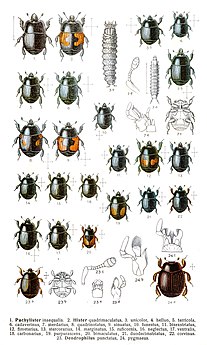Bacanius globulinus is a species of clown beetle in the family Histeridae. It is found in North America.
Bacanius is a genus of clown beetles in the family Histeridae. There are at least 70 described species in Bacanius.
Euspilotus azurescens is a species of clown beetle in the family Histeridae. It is found in Central America, North America, and South America.
Hister servus is a species of clown beetle in the family Histeridae. It is found in the Caribbean, Central America, and North America.
Margarinotus obscurus is a species of clown beetle in the family Histeridae. It is found in Africa, Europe & Northern Asia, North America, and Southern Asia.
Bacanius punctiformis is a species of clown beetle in the family Histeridae. It is found in North America.
Hololepta minuta is a species of clown beetle in the family Histeridae. It is found in the Caribbean, Central America, North America, and South America.
Gnathoncus barbatus is a species of clown beetle in the family Histeridae. It is found in North America.
Xerosaprinus coerulescens is a species of clown beetle in the family Histeridae. It is found in Central America and North America.
Hololepta populnea is a species of clown beetle in the family Histeridae. It is found in Central America and North America.
Epierus cornutus is a species of clown beetle in the family Histeridae. It is found in Central America and North America.
Xerosaprinus vitiosus is a species of clown beetle in the family Histeridae. It is found in Central America and North America.
Paromalus teres is a species of clown beetle in the family Histeridae. It is found in North America.
Hypocaccus fraternus is a species of clown beetle in the family Histeridae. It is found in North America.
Euspilotus assimilis is a species of clown beetle in the family Histeridae. It is found in North America.
Euspilotus rossi is a species of clown beetle in the family Histeridae. It is found in North America.
Plegaderus nitidus is a species of clown beetle in the family Histeridae. It is found in North America.
Onthophilus giganteus is a species of clown beetle in the family Histeridae. It is found in North America.
Geomysaprinus goffi is a species of clown beetle in the family Histeridae. It is found in North America.
Bacanius hatchi is a species of clown beetle in the family Histeridae. It is found in North America.


